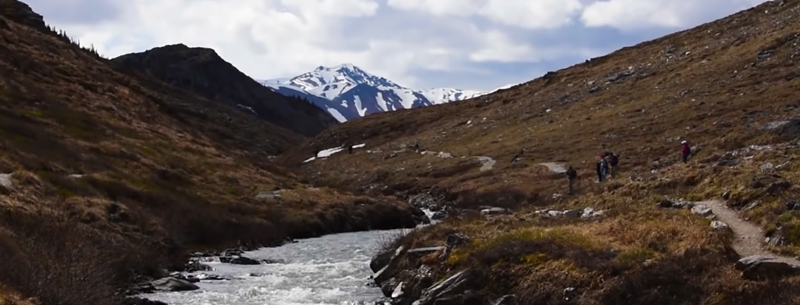Featuring the highest mountain in North America, Mount McKinley, Alaska‘s Denali National Park & Preserve is nature’s masterpiece. The Alaska Range includes countless other spectacular mountains and many large glaciers. Denali’s more than 6 million acres also encompass a complete sub-arctic eco-system with large mammals such as grizzly bears, wolves, Dall sheep and moose.
The park was established as Mount McKinley National Park on Feb. 26, 1917. The original park was designated a wilderness area and incorporated into Denali National Park and Preserve in 1980. The park was designated an international biosphere reserve in 1976. Today, the park hosts more than 300,000 visitors that take advantage of unparalleled wildlife viewing, mountaineering, and backpacking opportunities.
Visiting this park in the height of summer can be problematic. The visitor centers and hotels are a stream of RVs and tour buses. The only way to enjoy a solitary experience during this time is to undertake backcountry hiking. In winter, Denali is transformed into a ghostly, snow-covered world. Motorized vehicles are banned and northern lights (aurora) glitter over the snows.
Camping is the best way to experience Denali up close, with most of the park’s eight campgrounds open from May to September. The best views are at Wonder Lake with a stunning view of McKinley; Igloo Creek is good for spotting Dall sheep, while Riley Creek near the entrance is open year-round. To preserve flora and fauna, the only vehicles allowed in the park are a few tour buses and shuttle buses.
At the visitor center, you can pick up a free copy of the Denali Alpenglow paper and a wide range of literature, and join ranger-led activities including short hikes and the popular dog sled demonstration. Overnight backcountry camping is also a rewarding experience, but don’t expect it to be easy. There are no formal trails, and with river crossings and thick tundra, even experienced hikers are forced to go slow.
Denali Trivia
- More than 650 species of flowering plants grace the lower elevation slopes and valleys of Denali. The blooming season is brief, as snow can come in any month and winter usually arrives in force by October.
- A number of relatively short trails are available to visitors of all abilities in the park’s front country. The park’s vast backcountry does not have maintained trails, but is generally open to hiking, although overnight camping requires a permit.
- A typical year sees more than 1,100 climbers attempt to reach the summit of Mount McKinley, with about half reaching the 20,320-foot summit. The peak was first climbed in 1913.
- The park is open year-round, although most visitors arrive between May and September.
- Throughout the winter, campsites are open and the park road is left unplowed, making it ideal for cross country skiing, snowshoeing and dog sledding.
Denali Attractions
- Get on the bus, Gus! Private vehicles can generally drive the first 15 miles of the 90-mile park road throughout the summer without restriction. Beyond Mile 15, most visitors will use one of the park’s bus transportation systems.
- Sled dogs were a traditional method of travel in Alaska throughout the winter and are still used by the park to assist with winter projects in the park’s wilderness interior. In summer, the historic kennels are open to visitors and sled dogs make demonstration runs up to three times a day. The kennels are at Mile 3 of the park road and are served by a free entrance area shuttle bus.
- The south side of Denali is a 2-million acre expanse of wild country lying south of the crest of the Alaska Range. The South District Ranger Station in Talkeetna, about 150 miles south of the park headquarters, is the jumping-off place for activities that include wilderness camping, mountaineering and river running.
